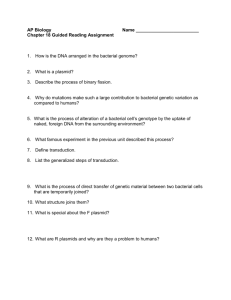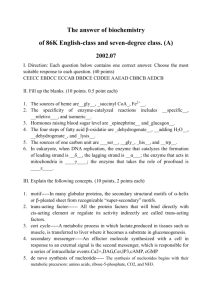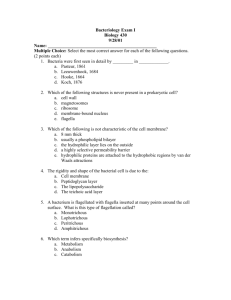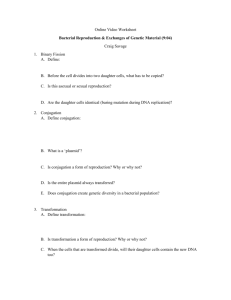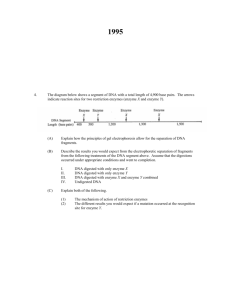Genetics of prokaryotic organisms
advertisement
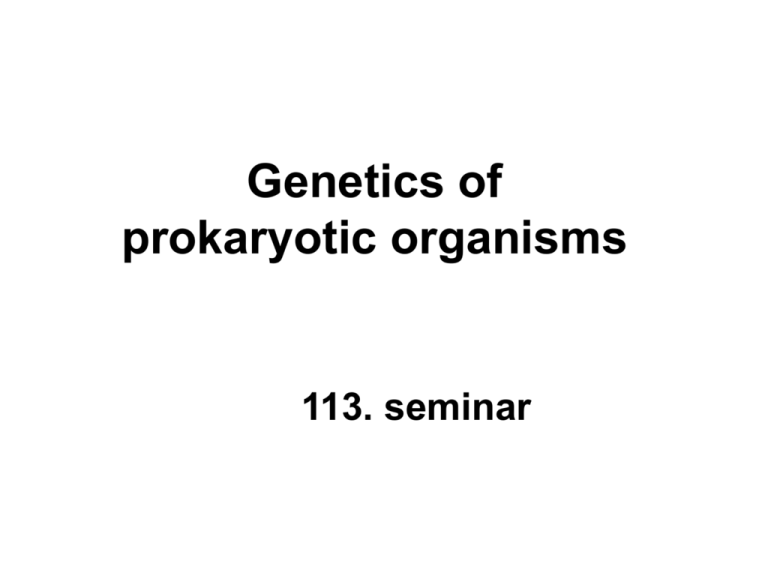
Genetics of prokaryotic organisms 113. seminar Genome Bacteria do not have true nuclei enclosed by membranes, either compartments by internal membrane systems. DNA is concentrated in nucleoid region, prokaryotic chromosome, which is the double stranded circle molecule. Genes of prokaryotic chromosome encode essential functions for cell. Genome‘s sizes of some bacteria Mycoplasma genitalium 0,58Mb Haemophilus influenzae 1,83Mb Agrobacterium tumefaciens Escherichia coli Salmonella typhi Mycobacterium tuberculosis Bacillus megaterium 2,84Mb 4,64Mb 4,81Mb 4,41Mb 30Mb There are also small circular molecules of DNA – plasmids, which encodes resistance to antibiotics or metabolism of unusual nutrients. Replicate independently of the main chromosome. Fertility F-plasmid, Resistance R-plasmid, Col plasmid, Virulence plasmid Plasmid sizes vary from 1 to over 1,000 kbp Michael Marshall, DNA-grabbing bacteria hint at early phase of evolution, New Scientist Magazine issue 2936, 26 September 2013. Genetic variability of prokaryotes Prokaryotes could developed in time, adapt to new environments, but they lack sexual cycle. Recombination of prokaryotic genetic information is managed by mechanisms, parasexual processes : Transformation – genes are taken up from surrounding environment Conjugation – genes are transferred directly from one to another through conjugative bridge Transduction – genes are transferred between prokaryotes by viruses Endosymbiosis, Somatic fusion Endosymbiosis Strachan and Read: Human genetics, 2. edition Mitochondria Plastids proofs: circle DNA without histons and introns Transcription begins by formylmethionin prokaryote type of ribosomes Some endosymb. organelles are inhibited by antibiotics Secondary symbiosis – between two eukaryotic organisms. Found protists of phylum Apicomplexa (Pasmodium,Toxoplasmosma……) e.g. in parasitic Bacterial transformation free intake of DNA into bacterial cells. Only competent bacteria with relevant proteins are capable of transformation (not Escherichia coli) 1. Experiment was done by Griffith (1928). It was proved that the carrier of genetic information is DNA. Avery, McLeod, McCarthy (1944) proved the same effect with isolated DNA. Griffith‘s experiment in 1928 Homologous parts exchange, it is called homologous recombination. Bacterial conjugation Cells with F-plasmid are F+, without F-plasmid are F- . Bacterial genes are transferred directly from one (F+) to another cell (F-). F plasmid encodes genetic information for conjugation and the origin of cytoplasmatic conjugative bridge and F-pilli. Hfr strain „High frequency of recombination“ is strain with the F plasmid integrated into genomic DNA (episom) Conjugation F+ into F- bacteria Bacterial conjugation It begins with single-strand break of donor‘s DNA. Single-strand enters the conjugation bridge, the donor cell synthesizes a new strand at the same time. The second strand is also synthesized in the acceptor cell. Then there is recombination between donor and acceptor parts of the chromosome and excision and elimination of incomplete replication. chromosomes without „ori“ = origin of Conjugation Hfr into F- bacteria Transduction Bacterial genes are transferred between prokaryotes by viruses. Bacteriophages transmit bacterial genes spontaneously. It comes to pass for all bacteria. Special transduction = incorrect cut out of the genome of bacteriophage (prophage) from the bacterial genome during the transition from lysogenic to lytic cycle of bacteriophage Special transduction Transduction General = into small number of phage particles are packaged molecules of bacterial DNA instead of phage‘s DNA molecules application in history - mapping of DNA: How often the genes are transmitted together in the general transduction, more about that are localized closer. General transduction Endosymbiotické organely Mitochondria – an origin in aerobic bacteria (Rikettsie) Plastids – an origin in cyanobacteria Some genes were transferred during evolution from mitochondrial genome to eukaryotic genome. Eukaryotic genomes have genes of prokaryotic type. Plenty of proteins with function in mitochondria are encoded in nucleus. Operon model is a functional unit common in bacteria and phages. Activation and inhibition of transcription are regulated in response of conditions in environment. Prokaryotic genetic information is not divided into introns and exons. Operon • is coordinately regulated clusters of genes, which are transcribed into one mRNA (polycistron transcript) • are genes for particular metabolic pathway and are regulated by common promoter and are ordered on DNA following each other Escherichia coli Lac operon, Trp operon – model systems = metabolic pathways of • utilization of lactose gen lacZ, lacY, lacA, catabolic pathway with negative and positive regulation • enzymes for TRP synthesis, anabolic pathway with negative regulation Each operon consists of • • • • promoter (for RNA polymerase = RNAP) operator (for repressor) several structural genes terminator repressor = allosteric protein encoded by regulatory gene co-repressor = product molecule inducer = substrate molecule Tryptophan operon Lac operon - negative regulation • regulatory gene produces repressor, which binds operator and causes that RNAP is not able to initialize transcription • in the presence of lactose repressor is released from operator. The repressor is changed by inducer = lactose RNA polymerase starts the transcription. In 2-3 minutes the amount of enzymes is increased 1000x Lac operon - negative regulation Lac operon - positive regulation • In the presence of glucose, E. coli preferentially uses glucose for decomposing. • If the level of glucosis is low, the level of cAMP is increased. • CAP „Catabolite activator protein“ in the presence of cAMP attaches promotor and activates the transcription. • CAP is allosteric regulatory protein Lac operon - positive regulation Summary: Lac operon is active only in time, when the activator CAP+cAMP is attached on promotor (no glucose) and when is not present represor on operator (lactose present) http://www.youtube.com/watch?v=7sZ5Nz8_cfc Thank you for your attention Genetika, D P. Snustad M.J. Simmons, 5. edition, 2009

